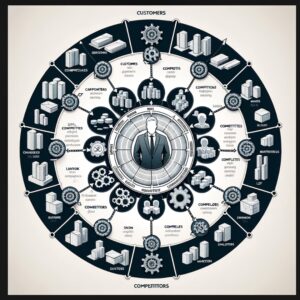Value Chain Analysis

Value Chain Analysis is a strategic tool used to analyze internal company activities. Its goal is to understand how various parts of a business create a product or service valuable to its customers. By examining each step of the value chain, a company can identify ways to increase efficiency, improve quality, and create the best customer experience, ultimately leading to competitive advantage.
The concept was popularized by Michael Porter and includes primary and support activities:
- Primary Activities:
- Inbound Logistics: Receiving, storing, and distributing inputs of the product.
- Operations: Processes of transforming inputs into the final product form.
- Outbound Logistics: Storing and distributing the final product to customers.
- Marketing and Sales: Activities to enhance buyer’s awareness and persuade them to purchase.
- Service: Post-sale services, including installation, repair, and customer support.
- Support Activities:
- Procurement: Acquisition of resources, services, and materials.
- Technology Development: Includes R&D, process automation, and other technology development to support the value chain.
- Human Resource Management: Recruiting, hiring, training, and development of employees.
- Firm Infrastructure: Company-wide activities such as finance, legal, quality management, and strategic planning.
By analyzing these activities, organizations can understand where they can create value and what could be improved. It’s not just about cutting costs; it’s about optimizing and aligning activities to deliver the highest possible value to customers.
Similar Tools and Methodologies:
- SWOT Analysis: Helps in identifying internal strengths and weaknesses, and external opportunities and threats, which can be related to different parts of the value chain.
- Balanced Scorecard: Provides a more comprehensive view of organizational performance, including financial, customer, internal processes, and learning and growth perspectives that intersect with various elements of the value chain.
- Lean Management: Focuses on eliminating waste within processes, highly relevant for optimizing operations in the value chain.
- Supply Chain Management: While Value Chain Analysis is focused internally, Supply Chain Management expands the scope to include external links with suppliers and distributors, which is crucial for optimizing inbound and outbound logistics.
Using Value Chain Analysis in conjunction with these tools can provide a holistic view of a company’s operations and help in creating a competitive edge by maximizing value creation and minimizing costs.



